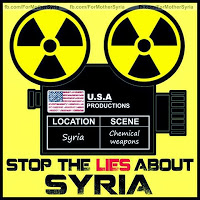 |
| image source |
Brandon Turbeville
Activist Post
Almost five months after the chemical weapons attacks that took place in the Ghouta region of Syria, legendary reporter and revealer of American war crimes such as My Lai and Abu Grahib, Seymour Hersh, has revealed yet another bombshell of information – specifically that the Obama Administration intentionally misrepresented information that was used to claim Assad and the Syrian government was responsible for the attack.
Hersh’s article, “Whose Sarin?” which was notably published in the UK press and not in the American media, claims that the Obama administration is guilty of “cherry picking” intelligence information to suit the goal of military action against Syria. Hersh’s accusations come after his conversations with at least two “intelligence and military officials.”
Ultimately, Hersh’s article rests on the criticism and revelations that the administration intentionally buried information regarding Jobhat al-Nusra operating inside Syria and the clear and documented evidence that the extremist group did, in fact, have access to sarin gas and the means to deliver it via improvised rocket propelling devices. Hersh also criticizes the American media for engaging in “confirmation bias” and riding the wave of propaganda being promoted against the Assad government.
In addition, the respected journalist points out that the administration actually manipulated evidence so as to attempt to portray the Assad forces as the aggressors. Hersh clearly states that the administration’s claims shortly after the Ghouta chemical weapons attack were nothing more than a fabrication, echoing the fabrication that famously preceded the tragedy of Iraq.
Hersh also states,
Barack Obama did not tell the whole story this autumn when he tried to make the case that Bashar al-Assad was responsible for the chemical weapons attack near Damascus on 21 August. In some instances, he omitted important intelligence, and in others he presented assumptions as facts. Most significant, he failed to acknowledge something known to the US intelligence community: that the Syrian army is not the only party in the country’s civil war with access to sarin, the nerve agent that a UN study concluded – without assessing responsibility – had been used in the rocket attack.
Hersh goes even further when he claims that the administration was well aware of the fact that the Nusra Front had access to Sarin and the means by which to deliver it. He writes,
In the months before the attack, the American intelligence agencies produced a series of highly classified reports, culminating in a formal Operations Order – a planning document that precedes a ground invasion – citing evidence that the al-Nusra Front, a jihadi group affiliated with al-Qaida, had mastered the mechanics of creating sarin and was capable of manufacturing it in quantity. When the attack occurred al-Nusra should have been a suspect, but the administration cherry-picked intelligence to justify a strike against Assad.
According to Hersh, the Defense Intelligence Agency was well aware of Nusra’s ability to acquire and deliver chemical weapons as far back as June 20, 2013. He says,
On 20 June a four-page top secret cable summarising what had been learned about al-Nusra’s nerve gas capabilities was forwarded to David R. Shedd, deputy director of the Defense Intelligence Agency. ‘What Shedd was briefed on was extensive and comprehensive,’ the consultant said. ‘It was not a bunch of “we believes”.’ He told me that the cable made no assessment as to whether the rebels or the Syrian army had initiated the attacks in March and April, but it did confirm previous reports that al-Nusra had the ability to acquire and use sarin. A sample of the sarin that had been used was also recovered – with the help of an Israeli agent – but, according to the consultant, no further reporting about the sample showed up in cable traffic.
In addition, Hersh demonstrates that not only the Defense Intelligence Agency, but the Central Intelligence Agency and the Joint Chiefs of Staff were aware of Nusra’s chemical weapons capabilities as well. Hersh states,
Independently of these assessments, the Joint Chiefs of Staff, assuming that US troops might be ordered into Syria to seize the government’s stockpile of chemical agents, called for an all-source analysis of the potential threat. ‘The Op Order provides the basis of execution of a military mission, if so ordered,’ the former senior intelligence official explained. ‘This includes the possible need to send American soldiers to a Syrian chemical site to defend it against rebel seizure. If the jihadist rebels were going to overrun the site, the assumption is that Assad would not fight us because we were protecting the chemical from the rebels. All Op Orders contain an intelligence threat component. We had technical analysts from the Central Intelligence Agency, the Defense Intelligence Agency, weapons people, and I & W [indications and warnings] people working on the problem … They concluded that the rebel forces were capable of attacking an American force with sarin because they were able to produce the lethal gas. The examination relied on signals and human intelligence, as well as the expressed intention and technical capability of the rebels.’
Yet there was more than simply the ignorance of intelligence pointing toward the death squads’ responsibility for the chemical weapons attack; there was a concerted effort to paint the Assad government as the responsible party. Hersh explains,
Once the scale of events on 21 August was understood, the NSA mounted a comprehensive effort to search for any links to the attack, sorting through the full archive of stored communications. A keyword or two would be selected and a filter would be employed to find relevant conversations. ‘What happened here is that the NSA intelligence weenies started with an event – the use of sarin – and reached to find chatter that might relate,’ the former official said. ‘This does not lead to a high confidence assessment, unless you start with high confidence that Bashar Assad ordered it, and began looking for anything that supports that belief.’ The cherry-picking was similar to the process used to justify the Iraq war.
[…]
The White House’s misrepresentation of what it knew about the attack, and when, was matched by its readiness to ignore intelligence that could undermine the narrative. That information concerned al-Nusra, the Islamist rebel group designated by the US and the UN as a terrorist organisation. Al-Nusra is known to have carried out scores of suicide bombings against Christians and other non-Sunni Muslim sects inside Syria, and to have attacked its nominal ally in the civil war, the secular Free Syrian Army (FSA). Its stated goal is to overthrow the Assad regime and establish sharia law. (On 25 September al-Nusra joined several other Islamist rebel groups in repudiating the FSA and another secular faction, the Syrian National Coalition.)
 The misrepresentation and outright fabrication of relevant information regarding who was responsible for the chemical weapons attack, however, did not stop at the White House. In typical fashion, mainstream media outlets joined in on beating the drums of war. Again, typically, the New York Times was at the forefront of pro-war propaganda. As Hersh writes,
The misrepresentation and outright fabrication of relevant information regarding who was responsible for the chemical weapons attack, however, did not stop at the White House. In typical fashion, mainstream media outlets joined in on beating the drums of war. Again, typically, the New York Times was at the forefront of pro-war propaganda. As Hersh writes,
An annex to the UN report reproduced YouTube photographs of some recovered munitions, including a rocket that ‘indicatively matches’ the specifics of a 330mm calibre artillery rocket. The New York Times wrote that the existence of the rockets essentially proved that the Syrian government was responsible for the attack ‘because the weapons in question had not been previously documented or reported to be in possession of the insurgency’.
The actual evidence, however, demonstrated quite the opposite. Much like what Tony Cartalucci reported in his article 5 Lies Invented to Spin UN Report on Syrian Chemical Weapons Attack (virtually deconstructing the propaganda narrative in real time), Hersh points out that the information intentionally misrepresented in the New York Times was easily exposed once it was held up to the light. He writes,
Theodore Postol, a professor of technology and national security at MIT, reviewed the UN photos with a group of his colleagues and concluded that the large calibre rocket was an improvised munition that was very likely manufactured locally. He told me that it was ‘something you could produce in a modestly capable machine shop’. The rocket in the photos, he added, fails to match the specifications of a similar but smaller rocket known to be in the Syrian arsenal. The New York Times, again relying on data in the UN report, also analysed the flight path of two of the spent rockets that were believed to have carried sarin, and concluded that the angle of descent ‘pointed directly’ to their being fired from a Syrian army base more than nine kilometres from the landing zone. Postol, who has served as the scientific adviser to the chief of naval operations in the Pentagon, said that the assertions in theTimes and elsewhere ‘were not based on actual observations’. He concluded that the flight path analyses in particular were, as he put it in an email, ‘totally nuts’ because a thorough study demonstrated that the range of the improvised rockets was ‘unlikely’ to be more than two kilometres. Postol and a colleague, Richard M. Lloyd, published an analysis two weeks after 21 August in which they correctly assessed that the rockets involved carried a far greater payload of sarin than previously estimated. The Timesreported on that analysis at length, describing Postol and Lloyd as ‘leading weapons experts’. The pair’s later study about the rockets’ flight paths and range, which contradicted previous Times reporting, was emailed to the newspaper last week; it has so far gone unreported.
While Hersh’s revelations are by no means anything new, they go some length in corroborating what many researchers and writers like myself, Tony Cartalucci, Webster Tarpley, Ziad Fadel, and others have been writing ever since the chemical weapons attack took place on August 21, 2013. Hersh’s article is particularly important due to its sources of military and intelligence officials and the open admission of the lack of any real evidence which would implicate the Assad government.
Yet, while information such as that provided by Seymour Hersh in “Whose Sarin?” is extremely important, it is also important to remember that such information was widely available at the time of the attacks and was provided by members of the alternative media. Thus, with the choices placed before the American people regarding whether or not to support war, stories such as this should serve as a reminder of just why the corporate media should be viewed as a highly discredited institution.
 One must also consider the fact that the information therein is nearly five months after the fact, despite the reality of its wide availability at the time of the controversy and debate. Far too many times, Americans have allowed themselves to be led down the path to war only to find out years or months later that the “intelligence” or information they were given was nothing more than a lie. Had the American people acquiesced to military action against Syria, the United States would have taken place in yet one more farce that ended as tragedy. Thus, it is important to remember such treachery on the part of the ruling elite and their mouthpiece media when a new propaganda narrative takes shape around Syria or yet more lies are used to pave the Path to Persia.
One must also consider the fact that the information therein is nearly five months after the fact, despite the reality of its wide availability at the time of the controversy and debate. Far too many times, Americans have allowed themselves to be led down the path to war only to find out years or months later that the “intelligence” or information they were given was nothing more than a lie. Had the American people acquiesced to military action against Syria, the United States would have taken place in yet one more farce that ended as tragedy. Thus, it is important to remember such treachery on the part of the ruling elite and their mouthpiece media when a new propaganda narrative takes shape around Syria or yet more lies are used to pave the Path to Persia.
Note: I encourage the reader to access my previous articles regarding the August 21, 2013 Ghouta chemical weapons attacks:
- New Chemical Weapons Attack In Syria Another False Flag?
- Propaganda Overdrive Suggests Syria War Coming Soon
- U.S. Positions For Attack On Syria
- Kerry Plays WMD Card in Next Step Toward War With Syria
- Snipers Fire At UN Inspectors: Another Rebel Crime?
- Total Fabrication Laid Bare in March to War With Syria
- 5 Ways ‘Incontrovertible Evidence’ on Syria is Controvertible
- Syria Chemical Weapons Victims Were Staged Using Kidnapped Hostages: Report
Also see: The Road To Damascus: The Anglo-American Assault On Syria
Read other articles by Brandon Turbeville here.
Brandon Turbeville is an author out of Florence, South Carolina. He has a Bachelor’s Degree from Francis Marion University and is the author of six books, Codex Alimentarius — The End of Health Freedom, 7 Real Conspiracies, Five Sense Solutions and Dispatches From a Dissident, volume 1 and volume 2, and The Road to Damascus: The Anglo-American Assault on Syria. Turbeville has published over 275 articles dealing on a wide variety of subjects including health, economics, government corruption, and civil liberties. Brandon Turbeville’s podcast Truth on The Tracks can be found every Monday night 9 pm EST at UCYTV. He is available for radio and TV interviews. Please contact activistpost (at) gmail.com.


Be the first to comment on "Seymour Hersh Confirms Obama Lied About Syria Chemical Weapons Attacks"